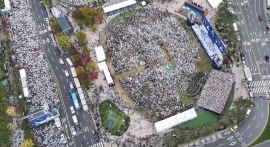

General Curtis M. Scaparrotti, the United Nations Command, Combined Forces Command, and United States Forces Korea commander, takes his first tour of the Joint Security Area and Observation Post Dora near Panmunjom, South Korea, Oct. 3, 2013.
The South Korean Ministry of Defense has announced that the administration and the United States have agreed to postpone the transfer of war time operations command to the year 2023. This is the 4th time the transfer has been postponed, but the Ministry of Defense announced that they had come to the conclusion there are too many factors to consider before deciding whether South Korea will not only be capable of defending itself in the case of a full-scale North Korean invasion but also lead the U.S. coalition to victory.
During the Korean War in 1950, the South Korean government gave General Douglas MacArthur full control over the Korean forces and command over the Korean forces has been in the hands of the USFK (United States Forces in Korea) until the year 1994, when the Korean government brought back the peace time operational command. Even today, in the case of a North Korean invasion of the south, the commander of the USFK will be supervising all the operations that will be involved.
However, the U.S. and Korea have agreed multiple times to transfer wartime operations command back to South Korea. It was the Korean government that proposed that the transfer be postponed after North Korea's early nuclear experiments and the sinking of the South Korean warship Cheon-An in 2010.
Yonhap News reported that the Ministry of Defense had come to the conclusion that the Korean military, though is currently the 11th most powerful military force in the world is still lacks certain capabilities to deal with something as large as a second Korean War. U.S. military analysts explained that there are certain areas that the ROK forces are completely reliant on the U.S. such as surveillance and intelligence.
The South Korean government announced that as of now, it appears that the transfer will take place in the year 2023, which is around the time the Ministry of Defense will complete the KAMD, a Korean versioned missile defense system that will be able to not only intercept incoming North Korean ICBMs but also target any point in North Korea. Korea is also planning to adopt a similar battle system called "Kill Chain". As of now, South Korea will have to rely on its Aegis Destroyers to fend off enemy missiles.
Yonhap News however, also reported that the KSDM project may not be completed over time because of some difficulties, adding that the 2023 transfer may not be kept.
Since the transfer will be delayed again, the USFK will remain stationed in Korea until the ROK forces become capable of independently defending its land from North Korean missile attacks. The U.S. has announced that it will be maintaining a system where South Korea, Japan and the U.S. will share valuable military information through satellite communications in order to ensure the safety of the Far East.
A recent survey by the Chicago Council on Global Affairs also showed that over 60 percent of U.S. citizens supported U.S. troops stationed in Korea in its defense of peace in East Asia.
Ever since the 1970s there have been many views regarding Korea's military capabilities and whether it is time for the nation to take its defense into its own hands, but it appears the Korean government has announced to the world that they are still not ready.



















